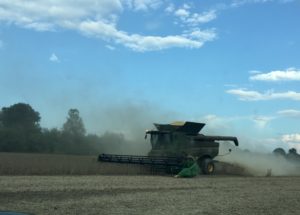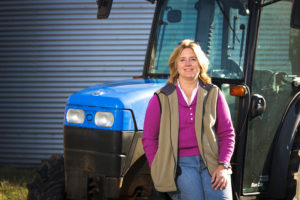
Harvest time on our Western Kentucky farm
For the average farmer, October 12th is no different than any other day. It’s another day to rise early, check the weather and prepare for the day’s tasks at hand. And most would say… “We don’t need a celebration, we’re just doing our job.” In fact, growing up I never realized there was a day to celebrate what my family had always done. But with the rise of social media comes the opportunity to highlight National Farmer’s Day – a day that has been designated since the 1800s.
So who do we celebrate today? Anyone that grows a garden? Perhaps, if you grow enough to sell! By the U.S. Department of Agriculture’s definition, a farm is “any place from which $1,000 or more of agricultural products were produced and sold, or normally would have been sold, during the year and at least one acre. (Source: USDA Economic Research Service Glossary of Terms) But who are the farmers responsible for the majority of the food on our table? Today’s U.S. agriculture is still largely family operated as 98 percent of all farms are family owned, from small farms with less than $250,000 gross sales to the very large ones with over $500,000 gross sales. Maybe we should proclaim this National Farm Family Day instead!

My mom at 93, the heart of the Smith family farm for 70+ years.
The Faces of the Farmer
Growing up, the typical farmer operator was male, which is still true today, but the number of women principal farm operators has risen to 12 percent, a number that represents a significant increase from as recently as 25 years ago when less than 5 five percent were women. (Source: USDA Economic Research Service. “Socially Disadvantaged Farmers: Race, Hispanic Origin, and Gender”) However, I think this number would have been higher if all the farm wives of 25+ years ago were counted as farmers!
For example, my mother, still living on the family farm at the age of 93, was truly a partner during the 51 years my family ran a dairy. During those years, her one constant was preparing the daily 5 a.m. breakfast for my father, but her farming duties increased as my brother and I left home and my grandfather passed away. In fact, her responsibilities and skill sets escalated in her late 50s and 60s when many of her church peers were thinking about slowing down. Baling hay, raising calves, paying all the farm bills, and tending garden were typical activities for her through her 70s.

Jennie Schmidt, a fellow dietitian & farm owner in Maryland — one of many women changing the face of farming.
Even though today’s statics reflect 36 percent of women operators being over the age of 65, the rate of women entering the field of agriculture and operating farms is increasing. Typically, women-operated farms are smaller but are more likely than the average farm to produce high-value crops, such as fruits, nuts and vegetables. For those operating large farms, horses, poultry and eggs typically make up their operations. In addition, many of the land grant universities’ agricultural programs today have a female majority population, which will continue to change the face of the farmer and farming operations.
The Challenges
Despite the romanticized image presented in Grant Wood’s 1930 “American Gothic” painting, farming technology has changed and will need to continue to evolve if we want to preserve a sustainable food production system for all.

The iconic “American Gothic” painting has defined the face of farming for generations. But that is all changing.
Perhaps this year more than ever we need to pause and thank our farmers. In recent months, farmers have dealt with floods in the southeast, drought in the west and tariff issues in the Midwest, along with the nationwide catastrophic decline of dairy farm profitability – all issues over which they had no control. Perhaps a quote by Jerry McReynolds, a northern Kansas wheat farmer and stockman sums it up best: “Farmers are trying to provide for their families and others. They are passionate about what they do, work tirelessly and carry more risk than most business would be willing to carry. It is a great life, but not always a great living.” (Source: Farm Policy Facts, “What’s in a Word: USDA’s Definition of Farmer Raises Hackles and Concerns“)
So today on National Farmer’s Day, pause, put down your fork, raise your glass and remember, you have food and drink today thanks to a farmer!
